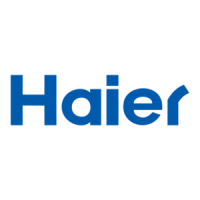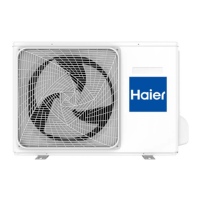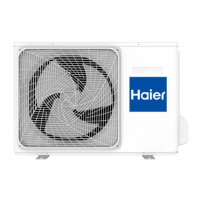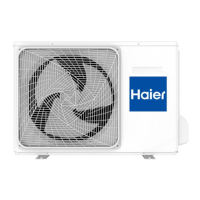Why does my Haier 1U35S2SM1FA-NR show a suction temperature sensor failure?
- JJoseph McmillanAug 6, 2025
A suction temperature sensor failure in your Haier Air Conditioner might be due to incorrect wiring or poor connection of the compressor.
Why does my Haier 1U35S2SM1FA-NR show a suction temperature sensor failure?
A suction temperature sensor failure in your Haier Air Conditioner might be due to incorrect wiring or poor connection of the compressor.
| Type | Split System |
|---|---|
| Cooling Capacity | 3.5 kW |
| Heating Capacity | 3.8 kW |
| Energy Efficiency Ratio (EER) | 3.21 |
| Outdoor Unit Weight | 30 kg |
| Cooling Capacity (BTU) | 12000 BTU |
| Refrigerant | R32 |
| Power Supply | 220-240V/50Hz |
| Indoor Unit Dimensions (WxHxD) | 800x290x200 mm |
| Outdoor Unit Dimensions (WxHxD) | 780x540x240 mm |
Ensures proper installation by qualified personnel, use of specified parts, and secure unit foundation to prevent hazards.
Covers procedures for preventing refrigerant leaks during installation and checks, emphasizing safe bleeding and leak detection.
Mandates minimum room sizes for R32 units to prevent safety issues from potential refrigerant leaks.
Encompasses ventilation, fire hazard avoidance, anti-static measures, site convenience, leak response, and damage handling.
Stipulates that all installation work must be performed by personnel holding relevant qualification certificates.
Explains the step-by-step process for charging nitrogen and performing leak detection using soapy water.
Covers fixation, connecting pipes, vacuumizing duration, pressure checks, and leak detection methods.
Lists critical items to check after installation and the consequences of improper installation for each.
Outlines steps for preparing the unit and performing the test run, including checking operation modes.
Specifies what maintenance is permissible at the user's site and highlights prohibitions on welding and disassembly.
Mandates that maintenance personnel must possess effective certificates for safety disposal of refrigerants.
Explains how to conduct leak detection using electronic equipment, focusing on safety and calibration.
Covers ventilation, fire prohibition, anti-static measures, leak response, and system earthing during maintenance.
Details system preparation, refrigerant handling, charging guidelines, and electrical component maintenance.
Outlines standard procedures for refrigerant clearing, purification, vacuumizing, and pipe cutting/welding.
Emphasizes ventilation, checking for refrigerant before welding, and safe purging methods.
Details best practices for refrigerant charging, including tool usage, pipe length, and earthing.
Covers technician familiarity, safe refrigerant recovery, power shutoff, protective equipment, and qualified personnel oversight.
Details safe handling of recovery cylinders, evacuation procedures, and charging limits to prevent overfilling.
Specifies ideal locations for installation, including required clearances around air inlets and outlets for optimal performance.
Covers immediate actions for abnormal phenomena, ventilation, base checks, and precautions against touching hot/cold parts.
Warns about risks associated with inflammable gases, improper installation, and refrigerant leaks, emphasizing professional service.
Emphasizes professional installation, stable placement, correct wiring, and securing covers to prevent electrical shock and fire.
Mandates use of R32 refrigerant and highlights safety measures for small rooms and relocation involving expert consultation.
Requires checking for refrigerant leaks after service and using only specified replacement parts to maintain safety.
Warns against reusing old piping and using conventional tools with R32, emphasizing the need for clean pipes and R32-specific equipment.
Details safe refrigerant charging practices, including using liquid R32, avoiding contaminants, and not using charging cylinders.
Prohibits installation in areas with flammable gas and specifies avoidance of unusual environments like those with high oil or chemical presence.
Details methods for securely mounting the outdoor unit to a foundation, ensuring stability and proper inclination.












